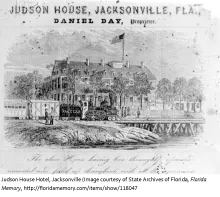1864 - The Federal transport steamer, Maple Leaf, struck a Confederate torpedo, now referred to as a mine, on the St. Johns River near Mandarin and sank immediately in three fathoms of water on this date. A detachment of Confederate artillery and a company of infantry troops were dispatched to the area to ensure that the wreckage was complete. The 181-ft long Maple Leaf was launched in 1851 in Ontario and was originally used as a freight and passenger vessel. It was leased to the U.S. Army in 1862 an used along the east coast as a military transport.
1874 - Marcellus Lovejoy Stearns, who was only 34 years of age, assumed the office of Governor of Florida (acting) on this date, following the death of Governor Ossian B. Hart. Stearns became the 11th governor (1874-1877) of the state. He was born in Lovell, Maine, and came to Florida as a member of the Freedman’s Bureau after having lost an arm while on duty with the Union Army. Stationed in Quincy, Stearns remained in Gadsden County following his release from military service.
1832 - The St. Augustine City Council passed an ordinance today authorizing the creation of tax-supported free schools in the city. This was one of the earliest such ordinances in the American South and in the nation. St. Augustine is the oldest continuously occupied European settlement in the United States, founded by Pedro Menedez de Aviles in 1565. It was the administrative center for East Florida during the British Period (1763-1783) and the Second Spanish Period (1783-1821).
1998- Judy Buenoano was executed by electrocution on this date. She was the first woman to be executed in Florida in 150 years and the first to die in the electric chair. The last woman to be executed before her was a freed slave who murdered a former master in 1848.
1863 - Federal army and naval forces continued evacuating Jacksonville on this date. As they evacuated, Union soldiers set fire to much of the town. Jacksonville was the center of Confederate military operations in Florida and the fires caused national outrage and debate over who was to blame. Rain helped to contain the fire, but the damage was already done as most of the city lay in ruins.
1833 - The Treaty of Payne’s Prairie was confirmed on this date with the signing of the Treaty of Fort Gibson. Seminoles agreed to the removal of the Seminole people from Florida in the Treaty of Fort Gibson, Arkansas, after their investigation of the new western lands. Removal would take place within three years.
1513 - Juan Ponce de Leon first sighted the Florida peninsula on this date, although he would not go ashore until April 2. The peninsula was sighted and mistaken for an island, which Ponce de Leon named “La Florida.” Ponce, who was most recently the Governor of Puerto Rico, set sail from that island on March 4th with three ships and approximately 200 men heading north towards an unknown landmass referred to as Biminy.
1863 - Floridians, like most Southerners, reacted angrily today when the Confederate Congress approved the Impressment Act on this date, which allowed Confederate tax collectors to impress food and other articles useful to the Confederacy.” The act was an attempt to regulate the already common Confederate army practice of impressing supplies including food and slaves. The legislation turned out to cause more strife when government pricing for impressed goods was demonstrably lower than their market value.
1822 - Lieutenant M.C. Perry took possession of Key West for the United States on this date. Perry was commanding the U.S. schooner U.S.S.
1967- A three-day riot pitting collegians against police during Spring Break began in Fort Lauderdale on this date. At least 500 people were arrested as a result. The riot was sparked when a student lay in the middle of A1A and the police got involved. By the 1960s, sun, beaches, and beer made south Florida THE destination for college students on Spring Break.











